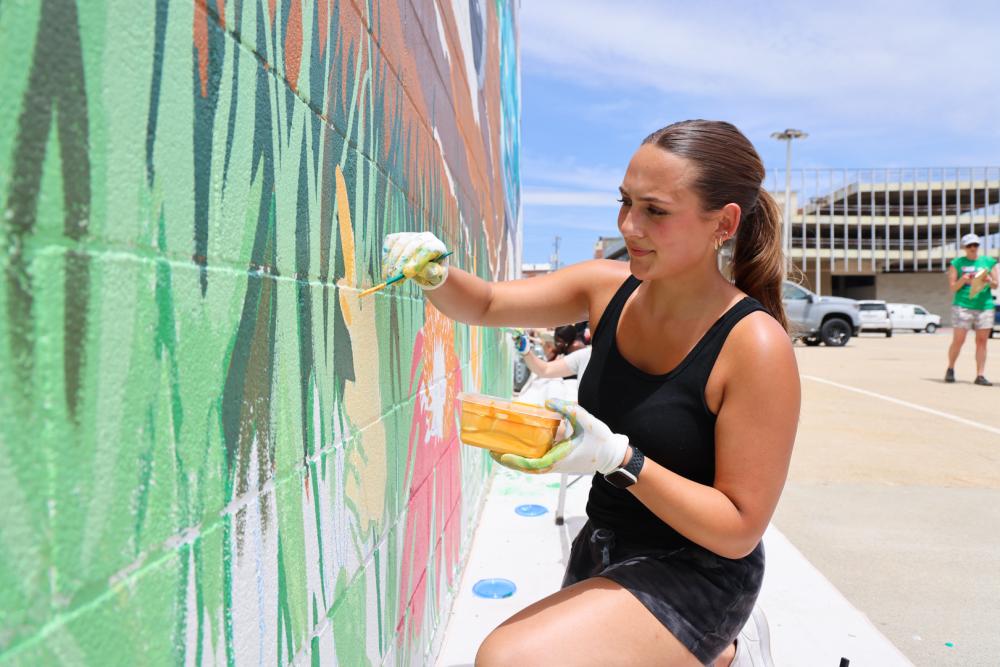
The city of Beatrice is no stranger to street art. In the last few years, a number of murals have been painted on walls and in alleyways throughout town, all designed by local artists. The production of the most recent mural, however, has been a little different. A collaboration between Nebraska Extension, students at the University of Nebraska–Lincoln, local business owners, and Beatrice youth, the mural links together the past and present of Nebraska.
Through an automotive theme, the mural ties together the past and present. It depicts a contemporary truck and vintage truck in front of a Nebraska landscape, and is painted on the wall of Premiere Chevrolet Buick GMC Beatrice, in downtown Beatrice. Maddie Vanderbur, the university student who created the design, did so as part of a street art class created and taught by Associate Professor Sandra Williams.

Members of the community join the "community paint day" in Beatrice to work on the city's newest mural designed by UNL student Maddie Vanderbur. Photo by Russell Shaffer
“With the rise of social media, we kind of get exposed to YouTubers and people doing all sorts of crazy murals all across the world,” said Vanderbur, a junior majoring in graphic design. “I’ve always wanted to do that. The scale is insane—I’m drawing on this little iPad, and then this wall is 20’ x 40.’ It’s definitely the biggest scale I’ve ever seen for my artwork.”
Created by Williams, the summer-term course came out of a discussion between university faculty, Rob and Andrea Schafer, and Duane Smith, who co-own Premiere and sponsored the mural. Williams says the course has a social-emotional application of adding visual appeal and fostering community pride.
“There’s a relationship between the arts and the daily lives of American people,” she said. “There are educational, social and economic benefits of widespread cultural access. It can transform public spaces and individual lives. It fosters youth development and ownership. Using the arts, they have community building powers that can, at times, combat feelings of social isolation or anxiety.”
On the practical side of the course curriculum, the students explore the history of street art in America, and cover the logistics of planning, budgeting, and community awareness and outreach. The main assignment is that students each create and submit a design for a mural.
While the Schafers and Smith chose Vanderbur’s as the final design to be painted, Vanderbur makes it clear that this project is and has been a team effort. The changes between projection and execution, the certifications to use the aerial lifts, the painting and securing of supplies were all made possible because the students collaborated on the project as a whole, she said, emphasizing the Beatrice youth who helped with the actual painting.
“This is super cool because you’re getting our whole community involved in something that everybody gets to drive by and see,” said Andrea Schafer, speaking of the youth. “They can say, ‘Hey, I took part in that. I helped paint that.’ It’s pretty neat to have something that’ll visually give you a smile as you’re driving by and brightens up the downtown.”
As the Nebraska Extension engagement zone coordinator in southeast Nebraska, Karly Black’s job is to help iron out the coordination and facilitate collaboration between rural communities and different departments at the university—in this case the School of Art, Art History and Design. She sees a vast array of benefits coming from this one course alone.
“This project allows the college students to gain new skills that they can utilize in their jobs outside of college,” she said. “They’re working with the business that is helping sponsor this mural, creating the mural, budgeting, working on this youth component, and doing community outreach. These could all be things that maybe they’re going to do in the real world.”
For Williams, the “community paint day” is the highlight of the course experience, and the pinnacle of what “community” means.
“At the end of the day, as an educator, even though I teach a lecture class, my most meaningful learning experiences were never sitting in front of a computer,” she said. “They were always when we were working together outside.”